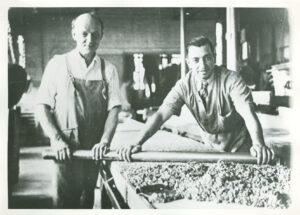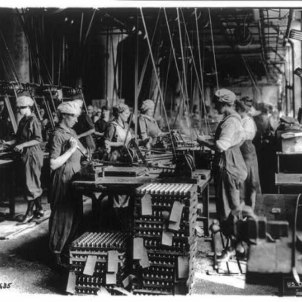
Who Is Essential Cambridge? Part 1: War and Industry
The first installment of our four-part conversation delves into the World Wars and the inter-war period to examine the role of Cambridge women in industrial production, a sector considered essential to the nation’s efforts to win both World War I and II and to maintain its global leadership position between and after the wars. At the beginning of the 20th century, women had a secure foothold in the paid labor force through their employment in factories producing everything from textiles to shoes to rubber goods to metal tools. In 1911, the trade union journal The Carpenter expressed outrage at the condition of female workers at the Blake & Knowles Steam Pump Company in Cambridge, as featured in a report by the American Federation of Labor. Even more offensive than the arduous tasks they are required to perform is the state of undress to which the extreme heat often drives the women, leading them to “[w]ork with their charred and grimy bodies bared to the waist.” Describing the owners of Blake & Knowles and other such factories as “[s]ilk-stocked parasites and other exploiters and degraders of womankind,” the author urges all readers concerned not only for the physical safety of women workers but for their virtue as well to rise up and overthrow the barons of industry. Indeed, in September of 1911, Massachusetts Governor Eugene Foss declared his support for a raid on the iron works of East Cambridge in order to remedy “unsanitary” working conditions and excessive work hours. Despite support from both the governor and the mayor of Cambridge, the investigation was short-lived, as there was no evidence of a violation of existing law at Blake & Knowles. Yet, in 1912 Massachusetts passed the Employment of Women in Core Rooms Act, which regulated the structure and location of the rooms, the emission of gases and fumes from ovens, and the size and weight of equipment with which the women were allowed to work. The year 1912 also saw Massachusetts enact the nation’s first minimum wage law, which applied only to women and children under age 18. Although in theory this law was designed to ensure adequate wages for these vulnerable groups, it instead served as a “wage ceiling,” effectively locking women into low-paying jobs without the ability to negotiate for higher wages.[1]
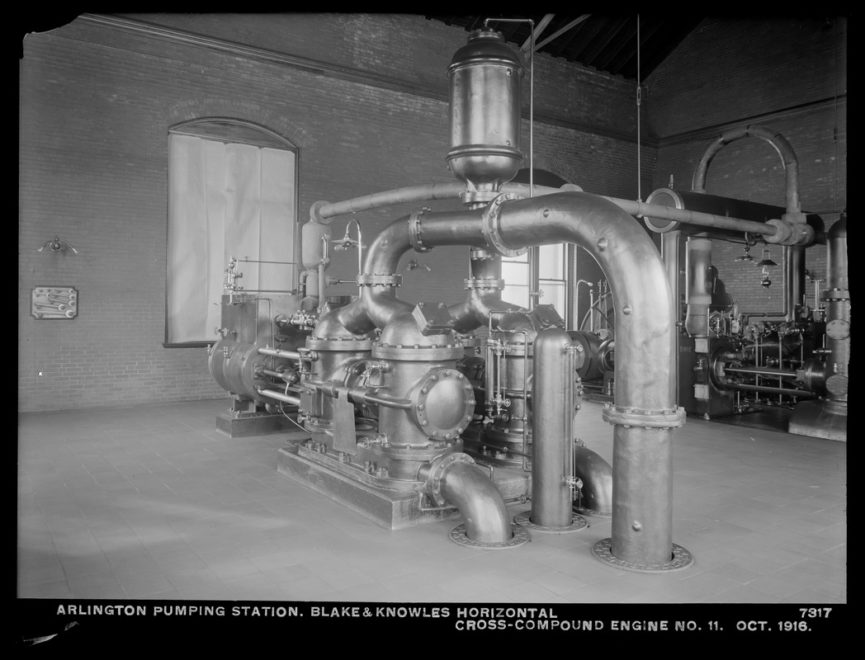
One tool available to Cambridge women unsatisfied with their pay or other working conditions was the strike. Long utilized by male workers to protest their treatment by factory owners and managers, the strike became increasingly popular among female workers in many industries during the early 20th century. In 1916, women at the American Rubber Company were swept up in the strike action of their male coworkers after all thirty-five men on staff walked out in protest over the company’s refusal to raise their pay from $12 to $15 a week. Because the employees worked in groups of five, with four women assisting every male sole roller, 140 women were temporarily unemployed when their male colleagues went on strike. Although the wage dispute was resolved in a matter of days, there is no mention of how much the women were making at American Rubber, or of any concern among the men of pressing for an increase in pay for their female coworkers.[2] But Cambridge women were also striking for themselves, as evidenced by the testimony of Mrs. Davis Dewey of the state board of labor and industry on several bills before the Massachusetts legislature in 1916. Discussing the difficulty of reconciling state and municipal laws governing the right of peaceful picketing, Dewey cited the case of several female Cambridge factory workers arrested for “loitering” under a Cambridge city statute while picketing during a garment-workers’ strike. While advocating for the Cambridge law to be changed so that it aligned with state law allowing peaceful protest, Dewey also took the opportunity to remind “her factory girls” that “their right to unite and protect their own interests is [their] greatest safeguard” and that they “should realize their own industrial value.”[3]

Once the United States entered into World War I in April of 1917, women’s industrial work took on a heightened importance as a part of the war effort. Many women who were already employed in the industrial sector saw their work change as factories pivoted to production of munitions and other wartime necessities. In 1917 the Women in Industry Service was created to study the conditions of women in war work (roughly 8.5 million in 1918), to be replaced three years later by the Women’s Bureau of the Department of Labor. In a report marking its 25th anniversary, the Women’s Bureau extolled the efforts of women in wartime production, noting that “[e]xperienced women who were already in manufacturing in 1917 were utilized largely for munitions making….Growing numbers of women were hired in such industries as iron, steel, lumber, transportation equipment, chemicals, metal and metal products and others….The peacetime work women were doing on punch presses, drilling machines, lathes, grinders, and polishers, as well as their high record of achievement in inspection, assembly, filing and other bench work in metal and electrical industries was well known to the bureau. The extent to which these developed skills would be useful to war-implemented industries was easily demonstrated.”[4]
But once the war was over, what would happen to the women who had begun or increased their positions in the paid labor force? Much thought was given to this question by businessmen, social scientists, politicians, and many others, with the prevailing opinion that many women would be glad to resume their duties as wives, mothers and homemakers when men came home from the front. While for some women this was true, many others – due either to the need to continue earning an income or the desire to remain in the paid labor force outside of the home – continued their industrial work. Speaking to the Boston Globe in 1918, an agent for the Boston Bricklayers’ Union expressed their support for a six-day workweek of six hours per day, which “[h]e fully believes would also allow women to retain their present occupations, regardless of the return of millions of soldiers to civilian life.”[5] Postwar advertisements for Cambridge and Boston factories called for “[w]omen who have had experience in machine shops or munition plants” at competitive salaries.[6] Striking had by this time long been seen by many in American industry as a socialist tactic but, in the wake of the war and the Russian Revolution, many critics sought to publicly associate labor strikes with Bolshevism to the extent that organized labor came under suspicion as not only greedy and lazy, but as fundamentally un-American. The extent to which this opinion had permeated into much of everyday life is exemplified by the fact that the subject of 1920’s annual Durrell Prize debate at the Cambridge High and Latin School was “Should the right to strike be prohibited to the employees of essential industries?” Students on the winning side argued in favor of disallowing essential workers to strike.[7]
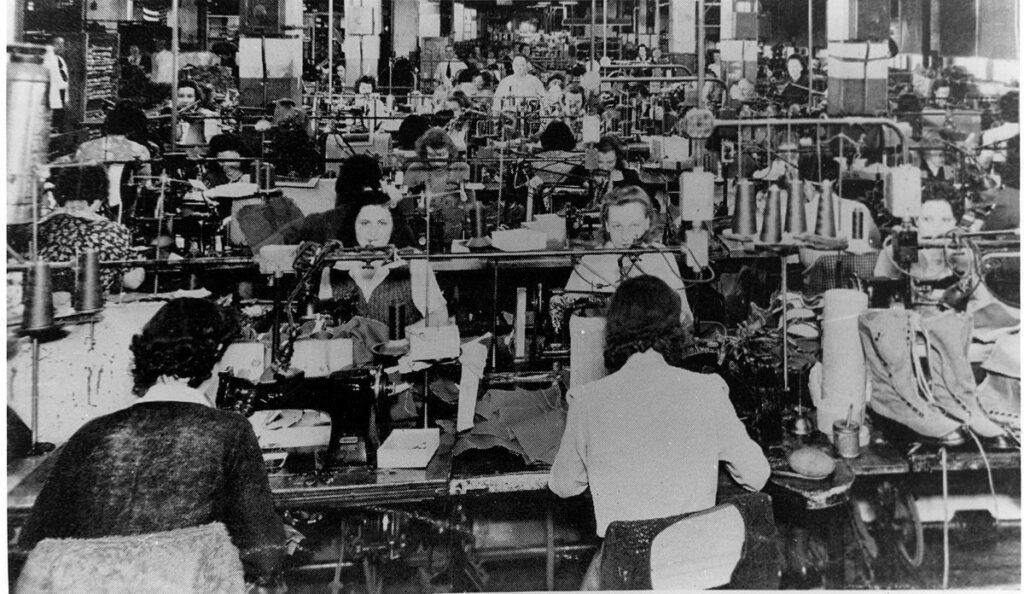
Despite prevailing opinions, Cambridge women continued to work in industry between the World Wars, and continued to strike when they were dissatisfied with their pay or working conditions. In 1933 and 1936, striking female workers in the shoe and garment industries, respectively, were arraigned in the East Cambridge court on charges of loitering and assault and battery. In the case of the shoe workers, a reporter for the Boston Globe described the courtroom as “crowded with shoeworkers, strikers and strike sympathizers,” indicating that the women had at least a modicum of popular support for their protests.[8] Once the United States began producing munitions and other supplies for our European allies involved in World War II – and later, once the U.S. formally entered the war – women’s participation in and importance to defense production spiked again, although the patriotism of wartime combined with the widely-recognized necessity of women’s industrial labor let to a temporary halt in strikes and other work actions.
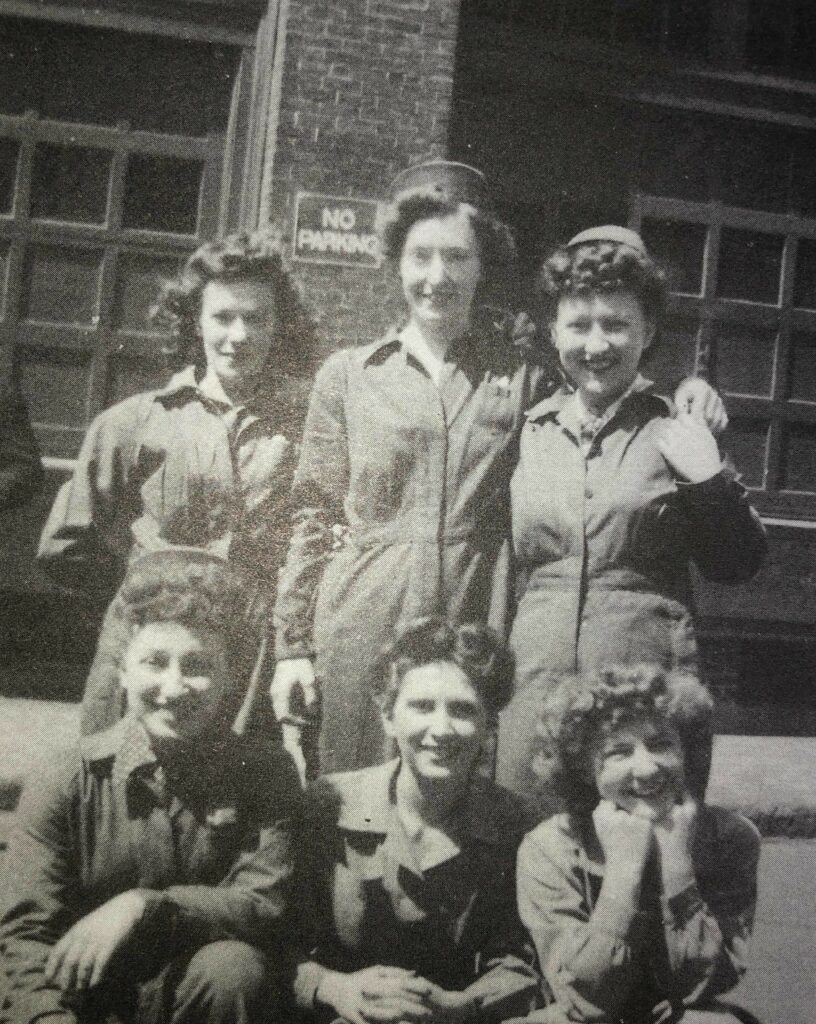
Because a much greater number of American men served in the armed forces during World War II than had served in World War I, the women in their families – mothers, wives, daughters and sisters – bore much of the burden of both the economic and emotional survival of the family in their absence. This was certainly true of Cambridge women, who relied on one another to create female networks on which they could depend as they balanced paid and unpaid labor. Doris Lester Gregory recounted her wartime experience living and working in East Cambridge while her husband was away serving in the army. She recalled working nights at the E.B. Badger Company, during which time “I boarded the kids around the corner with a big, jolly woman with a French name who came from Northern Ireland. She took in kids from the neighborhood during the day.”[9] Gregory would pick up her children on her way home from work in the morning; her older son spent the day at school, but her younger son was home with her and “[he] and I would lie down and sleep. I slept as long as he slept. If he slept two or three hours, that’s what I got. It was hard because I was working at night, and I had to be awake or I would get hurt with the high-powered tools I used on the job.”[10] In her work at E.B. Badger, Gregory describes the accommodations that the factory had to make for her and other women workers who were considerably smaller than the men they were replacing. She recalls the foreman saying, “We have to accommodate her lack of height, because there’s nothing wrong with her up here (meaning my brains).” Once her assignment at Badger ended, she went to the Navy Yard and went through a training course to learn riveting and welding, after which she worked as a riveter for the remainder of the war. Looking back on the end of her wartime labor, Gregory concluded that “the United States treated her women workers in an appalling manner. They hired us, trained us, used us, and when the guys came back, they discarded us. We did a good job, but there was nothing for us built in for our future when we got older.”[11]
The difference in both wages and responsibility during wartime can be seen in a comparison of the experiences of two Central Square residents in the early 1940s. Helen O’Brien Geis worked in the Simplex factory making ship cable. She describes her work covering the wires in cotton as “so darn dirty with all the dust and dirt from the cotton, I’d get sneezing and coughing.”[12] But she also notes that hers was one of the better-paying jobs for women, especially after a pay raise from $13 to $18 a week. In contrast, Jim Mastrullo described his work at Simplex in 1940 producing the same ship cable as “a lousy job.”[13] He noted that his salary of $22 a week was unsatisfactory, and recounts a summer day when he decided, “I should be at the beach. I went to Personnel and said, ‘Give me my money and let me go,’ They paid me off in cash.”[14] Although our knowledge about the family situations of Geis and Mastrullo is limited, the fact that they earned different wages for the same work (and that Mastrullo was able to decide abruptly to quit his job) indicates that single men during this period both made more money for the same work and were less encumbered by the family caretaking responsibilities shouldered by women.

As the war progressed and more energy and materials were devoted to defense production, the United States expanded its efforts to recruit women for war jobs. A report published in August of 1943 declared that “[n]early two million more women must be recruited for war jobs before the end of the year.”[15] An article in the Cambridge Sentinel summarizing the report extolls the contributions of women to industrial production, emphasizing the mechanical and technological innovations that factories had created to allow smaller and weaker women to do the jobs previously performed by men – innovations which would ultimately benefit all workers once the war was over. It also explores the issue which caused so much concern after the first world war: would women be content to retreat back into the domestic realm after their experiences in the “male” world of war work? The article’s author not only raises the question of the effect of women’s wartime labor on marriage dynamics and household income, but also asks what will become of these women’s children should they continue to work. Although the report concedes that these are difficult and multi-layered issues to consider, its conclusion is that “[h]aving millions of women who can do skilled work is hardly a thing for any nation to deplore. New products will mean a higher standard of living and thereby better health and educational opportunities for all.”[16] Likewise, a 1945 article in the Sentinel marking the 25th anniversary of the Women’s Bureau both applauds the contributions of women as essential workers in war production and recognizes their continued presence in the industrial workforce after the war’s end. Quoting the Director of Munitions, the article gives readers advice to “dovetail the skills and experiences of men and women workers so as to produce all the varied and numerous goods and services needed for a well-balanced economy and well-rounded living for all our people.”[17]
As more women than ever made their way into the paid workforce in the second half of the 20th century in Cambridge and beyond, both their work and home lives remained circumscribed by gendered notions of economic and domestic labor. In Part 2 of our series we will explore the role of Cambridge women in the teaching profession; in examining how the education of children was seen as a natural outgrowth of maternal affection, we will see the ways in which teachers’ “essential” labor has been both exalted and used to limit their efforts to improve their own economic well-being.
[1] For more on women at the Blake & Knowles Co., see The Blake & Knowles Steam Pump Works in East Cambridge: The Female Foundry.
[2] “Rubber Workers Strike,” Cambridge Chronicle, March 11, 1916.
[3] “Protection of Factory Girls,” Cambridge Chronicle, April 15, 1916.
[4] “Women’s Bureau of Labor Department 25 Years Old; Busy With Present and Postwar Needs of Workers,” Cambridge Sentinel, February 10, 1945.
[5] “Union Agent Thinks Work Week of 36 Hours Enough,” Boston Globe, July 7, 1918, p. 12.
[6] Boston Globe, June 17, 1919, p. 19; August 20, 1919, p. 16.
[7] Cambridge Tribune, May 8, 1920 and May 29, 1920.
[8] “Cambridge Strike Cases Continued,” Boston Globe, May 24, 1933, p. 13; “Seven Fined $145 in Strike Cases,” Boston Globe, July 15, 1933, p. 18; “Sixteen Strikers in Court in Cambridge,” Boston Globe, February 27, 1936, p. 12; “16 Arrests in Cambridge,” Boston Globe, February 28, 1936, p. 24.
[9] Boyer, Sarah. All in the Same Boat: Twentieth-Century Stories of East Cambridge. Cambridge Historical Commission, 2005, p. 143.
[10] Ibid.
[11] Ibid, p. 144.
[12] Boyer, Sarah, Ed. Crossroads: Stories of Central Square 1912-2000. Cambridge Historical Commission, 2001, p. 134.
[13] Ibid, p. 135.
[14] Ibid.
[15] “Two Million More Women Needed for War Plants; Twice That Number Ready, Says Census Survey,” Cambridge Sentinel, August 28, 1943.
[16] Ibid.
[17] “Women’s Bureau of Labor Department 25 Years Old; Busy With Present and Postwar Needs of Workers,” Cambridge Sentinel, February 10, 1945.





